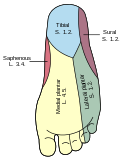| Medial sural cutaneous nerve | |
|---|---|
 Medial sural cutaneous nerve shown in its common anatomic formation | |
 Cartoon version adapted from Steele et al. depicting type 1 sural nerve with contribution of medial sural cutaneous nerve and sural communicating branch | |
| Details | |
| From | Tibial nerve |
| Identifiers | |
| Latin | n. cutaneus surae medialis |
| TA98 | A14.2.07.061 |
| TA2 | 6585 |
| FMA | 44687 |
| Anatomical terms of neuroanatomy | |
The medial sural cutaneous nerve(L4-S3) is a sensory nerve of the leg. It supplies cutaneous innervation to the posteromedial leg. [1]






